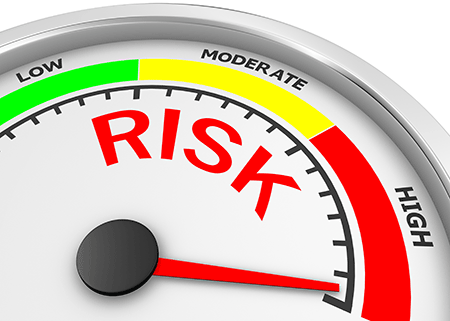Trading Risks: 7 Tips to Keep You Safe

By Dale Gillham
The stock market can seem like a minefield for uneducated traders who don’t understand the risks of trading. If you are someone who believes that the stock market is risky and/or you worry about losing money, then you are probably like so many others who apply a hit and miss approach to their trading.
The reality is that many take on too much risk when trading the stock market, when they could be getting better returns by taking far less risk.
Safely navigating your way in the stock market is a challenge for many, but you can minimise your trading risks and increase your odds of success by applying solid trading rules and a proven trading system. So I will share with you 7 tips to keep you safe, as this will ensure you do not blow yourself up when challenges present themselves in the market, like the gentleman did in the story that follows.
A true story about the risks of trading

I recall a conversation a few years back with a middle-aged guy named John. He had a wife, a couple of young kids, and he had worked for years in a labouring job, which was taking its toll on his body.
He had read online how much money could be made in the market, so he set up a trading account with an online broker and started trading. Now everyone who makes their debut onto the market hopes this will occur when the market is rising, and the good news for John was that he had caught a wave and was riding high as the market rose.
However, history demonstrates, time and time again, that most traders are totally unprepared for when conditions change, and they never believe that the worst could happen to them, until it’s too late. After all, bad things only happen to other people.
John called into the office one afternoon after I had sent out an email about the trading risks many traders take in the market, which really rang true for him. He knew he needed help but admitting this to someone was one of the hardest things for him to do.
His ego had taken a huge hit when the market pulled back swiftly, wiping out his bank account, and more. The good news was that John had recognised that it wasn’t just the fact the market had fallen away that was the problem, it was what he had failed to do.
As I listened to him tell his story, I could hear the pain in his voice when he recalled the events of the past couple of years and I really felt for him.
What he shared was all too familiar, as I had heard this story many times before. John had made a bucket load of cash from the market in a very short period of time. And it was far more money than he had ever made in a year from his full-time job. But he made a fatal mistake and it cost him dearly.
Let me share with you what he did, so you might learn from his mistakes.
Why this trader took on too much trading risk
John was making so much money but he decided he could make a whole lot more by taking on more risk using leverage to trade shares. So he borrowed as much money as he could and geared up his positions to the maximum as the market rose.
He honestly believed he was a great trader, even though he had no real education, and he also believed he had finally found his calling in life. So much so, he decided to quit his full-time job to become a full-time trader and trade for a living.
Now there is nothing wrong with wanting to exit your full-time job; in fact, many of my students have done just that. However, let me say, first and foremost, that it must be done the right way and with a proper plan, not with a hit and miss approach.

Experience and the right knowledge would have told him that his approach was flawed and very high risk, but John had neither, so he was living in a false reality. John also believed that he wasn’t a gambler, however, the market soon showed him that what he was doing was in fact gambling, and in a big way. It also showed him that he lacked the knowledge and experience required to manage the trading risks he had taken on.
When the market eventually pulled back, he lost hundreds of thousands of dollars. And to make it worse, John had only just recently moved into a new home, and not just any home…it cost him four times the value of the house that he had previously lived in on his labourer’s wage.
His house of cards came tumbling down and his whole perspective changed in a very short period of time. Instead of exiting the market, John began to take on more risk by chasing his losses, and he lost even more.
To top it off, he and his wife were fighting, he was angry all the time, and started drinking. He couldn’t pay the mortgage on his new home despite uprooting his children from their school and their friends for this new life. Sadly, his wife eventually left him and took the kids.
Tools to manage your risk
But here is the kicker, a very simple tool such as risk management, along with proper buy and sell rules would have saved John from his demise. The unfortunate reality is that most venture into the stock market without giving these strategies any thought.
The good news is that John hadn’t given up. He finally admitted to me that he had no real structure to his approach and needed a system that would allow him to apply more discipline in his trading so that he could gain more consistency and certainty.
After a long conversation, John came to the realisation that he made three fatal mistakes:
- Firstly he failed to properly educate himself. Instead he had spent time watching videos on Youtube, reading a few books, and finding free stuff on the internet, none of which really prepared him for what he was doing;
- Secondly, he did not understand the risks of trading particularly when it comes to leveraging and how to manage this; and
- Thirdly he failed to exit his full time employment with a plan.
Getting this right is not rocket science but it is likely to be the difference between you living the dream or experiencing a nightmare…and the path you choose is really up to you.
You can either tiptoe through the minefield like John initially did or you can learn how to avoid the mines altogether, as he now does.
7 tips to keep you safe
So here are seven tips I teach traders to follow, which will keep you safe and stop you from stepping on a land mine.

- Your biggest risk stems from a lack of knowledge, skill and experience in the market: There is a direct correlation between knowledge and risk. The more knowledge you have the better you are able to manage the trading risks. And the best way to minimise your risk is to educate yourself properly before you trade. You need to recognise that what you pay now to learn properly is much less than what the market will take from you if you don’t gain a solid education. Remember, the market will always be there but you may not if you lack the knowledge and skill.
- Know the risks you are taking at all times: Because investing without a stop loss is high risk. A stop loss allows you to decide upfront how much money you are willing to risk before you trade. It’s not what you stand to make that is important, but what you do not lose.
- Trading without a proper plan is gambling: We all know the saying “fail to plan and you plan to fail”. I think Warren Buffet got it right when he said “Someone's sitting in the shade today because someone planted a tree a long time ago”. Most traders I meet do not have a plan or do not know how to create a proper trading plan. But make no mistake, this process is critical to you reducing your trading risk and increasing your success.
- Never buy a stock just to get a dividend: Always buy for capital gains first and dividends second, as the dividend is the icing on the cake, not the cake itself.
- Never take tips, no matter how tempting it is or who it’s from: Trading someone else’s tips only increases your risk. And hoping that someone else’s tip will perform rather than knowing yourself is gambling. You are far better off learning how to pick the right stocks based on your tolerance to risk and applying rules that you know how to manage. One of my favourite sayings is give a man a fish and he can eat for a day, teach a man to fish and he can eat for life.
- Never buy a stock because it appears cheap: As you will get it wrong nearly every time. Cheap doesn’t mean you will get a ‘bargain’ in the stock market. That’s because if a stock is falling in value, remember, it can, and most likely will, get a lot cheaper. Always buy quality shares that you know are rising, as these are the most liquid stocks on the market and are more likely to continue to rise.
- Don’t over-diversify your portfolio: While it is true that diversification reduces risk, a portfolio that is over diversified (more than 12 stocks) will generally mirror the market. I recommend that most traders hold between 8 to 12 stocks in their portfolios, as this ensures they have a well-diversified portfolio. The longer the time frame when trading, the higher the number you should hold; therefore, short term traders may prefer to choose between 5 and 8 positions.
Remember, there are only two things we can control when it comes to the stock market, when you buy and when you sell. It is not good enough knowing when to buy if you cannot apply the brakes to manage your trading risk. Knowing how and when to sell is critical to your long term success as a trader. Given this, it is essential to understand how to get both right so you can profit consistently and adequately manage your trading risk.
So let’s get into this week’s stocks. Watch the video to find out more.
Others who read this also enjoyed reading:






